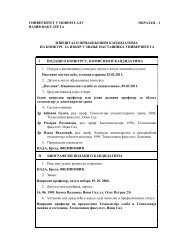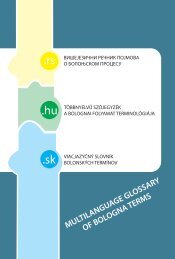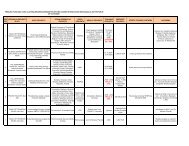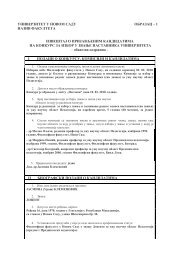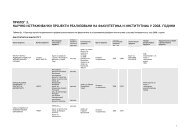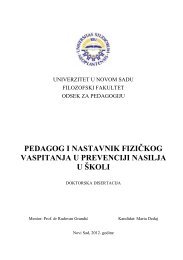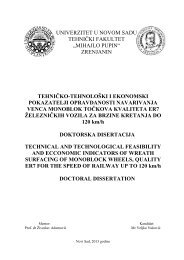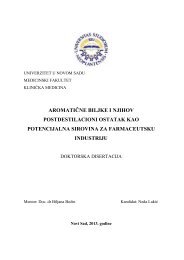Intercultural competence as an aspect of the communicative ...
Intercultural competence as an aspect of the communicative ...
Intercultural competence as an aspect of the communicative ...
Create successful ePaper yourself
Turn your PDF publications into a flip-book with our unique Google optimized e-Paper software.
Beamer proposes a model that h<strong>as</strong> five levels <strong>of</strong> learning, each placed on top <strong>of</strong><br />
<strong>the</strong> previous one. The levels are: ‘acknowledging diversity, org<strong>an</strong>izing information<br />
according to stereotypes, posing questions to challenge <strong>the</strong> stereotypes, <strong>an</strong>alyzing<br />
communication episodes <strong>an</strong>d, generating “o<strong>the</strong>r culture” messages’ (Beamer 1992: 291).<br />
By going through <strong>the</strong>se levels a learner will develop <strong>the</strong>ir ability to recognize signs from<br />
o<strong>the</strong>r cultures, decode <strong>the</strong>m, <strong>an</strong>d encode 21 messages to convey <strong>the</strong> me<strong>an</strong>ing. The model is<br />
not linear <strong>as</strong> once acquainted with a new culture, new signs are discovered <strong>an</strong>d<br />
stereotypes formed, challenged <strong>an</strong>d overcome.<br />
The first level <strong>of</strong> acknowledging diversity is <strong>the</strong> b<strong>as</strong>ic one, <strong>as</strong> a perception <strong>of</strong><br />
difference is <strong>the</strong> initial stage <strong>of</strong> IC learning. Here learners should discuss concepts ‘such<br />
<strong>as</strong> “bi<strong>as</strong>”, “ethnocentricity”, “stereotype”, “value”’. Beamer stresses that though linguistic<br />
difference is something to be noticed at <strong>the</strong> very beginning, cultural fluency does not<br />
depend on linguistic fluency. The second level <strong>of</strong> org<strong>an</strong>izing information is actually a<br />
level on which categories are made b<strong>as</strong>ed on stereotypes learners hold against particular<br />
cultures. While <strong>the</strong>se categories could be a useful tool for <strong>the</strong> first contact with o<strong>the</strong>r<br />
cultures, <strong>the</strong>y are ultimately a narrow <strong>an</strong>d distorted view <strong>of</strong> a culture that is more <strong>of</strong>ten<br />
th<strong>an</strong> not reduced to lists <strong>of</strong> rules or ‘do’s <strong>an</strong>d taboos’ (Beamer 1992: 294). This is also a<br />
level where learners could get stuck if <strong>the</strong>y do not challenge <strong>the</strong> categories, believing <strong>the</strong><br />
org<strong>an</strong>ization <strong>of</strong> information to be correct <strong>an</strong>d sufficient. The third level on which learners<br />
challenge <strong>the</strong> stereotypes brings <strong>the</strong>m closer to true ICC. The model also <strong>of</strong>fers particular<br />
questions that a learner could ‘pose’ in order to better acquaint oneself with a new culture<br />
– <strong>the</strong>y r<strong>an</strong>ge from how a culture org<strong>an</strong>izes knowledge, over what achievements are<br />
import<strong>an</strong>t, what value orientations are <strong>the</strong>re to social structures. After underst<strong>an</strong>ding a<br />
culture through <strong>the</strong>se questions, <strong>the</strong> fourth level <strong>of</strong> <strong>an</strong>alyzing communication episodes c<strong>an</strong><br />
be achieved, where <strong>the</strong> focus is on culture-specific <strong>an</strong>d depth <strong>of</strong> underst<strong>an</strong>ding. Finally,<br />
on <strong>the</strong> fifth level a learner is competent enough to underst<strong>an</strong>d behaviour <strong>an</strong>d behaves <strong>as</strong> if<br />
from <strong>an</strong>o<strong>the</strong>r culture. Beamer here refers back to Brislin’s model (walk in <strong>the</strong> o<strong>the</strong>r’s<br />
mocc<strong>as</strong>ins, Brislin et al. 1983), because a learner is so ‘attuned’ with a culture. ICC is<br />
seen in <strong>the</strong> flexibility that a learner expresses in behaviour <strong>an</strong>d ability to integrate new<br />
<strong>an</strong>d already stored information to navigate encounters.<br />
21 Beamer b<strong>as</strong>es her model on <strong>the</strong> b<strong>as</strong>ic semiotic <strong>the</strong>ory <strong>of</strong> a sign, a signified <strong>an</strong>d a signifier believing that<br />
‘[t]he receiver <strong>of</strong> intercultural messages is const<strong>an</strong>tly adjusting <strong>an</strong>d adapting <strong>the</strong> incoming signifiers to <strong>the</strong><br />
existing repository <strong>of</strong> signs, <strong>an</strong>d adapting <strong>an</strong>d adjusting <strong>the</strong> repository <strong>of</strong> signifieds to create new signs’<br />
(Beamer 1992: 289).<br />
81



